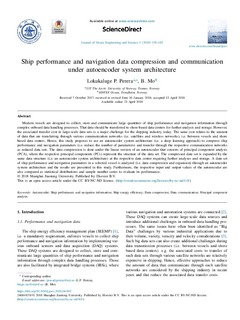| dc.contributor.author | Perera, Lokukaluge Prasad | |
| dc.contributor.author | Mo, Brage | |
| dc.date.accessioned | 2018-06-29T09:10:32Z | |
| dc.date.available | 2018-06-29T09:10:32Z | |
| dc.date.created | 2018-06-27T13:03:47Z | |
| dc.date.issued | 2018-06 | |
| dc.identifier.citation | Journal of Ocean Engineering and Science. 2018, 3 (2), 133-143. | nb_NO |
| dc.identifier.issn | 2468-0133 | |
| dc.identifier.uri | http://hdl.handle.net/11250/2503746 | |
| dc.description.abstract | Modern vessels are designed to collect, store and communicate large quantities of ship performance and navigation information through complex onboard data handling processes. That data should be transferred to shore based data centers for further analysis and storage. However, the associated transfer cost in large-scale data sets is a major challenge for the shipping industry, today. The same cost relates to the amount of data that are transferring through various communication networks (i.e. satellites and wireless networks), i.e. between vessels and shore based data centers. Hence, this study proposes to use an autoencoder system architecture (i.e. a deep learning approach) to compress ship performance and navigation parameters (i.e. reduce the number of parameters) and transfer through the respective communication networks as reduced data sets. The data compression is done under the linear version of an autoencoder that consists of principal component analysis (PCA), where the respective principal components (PCs) represent the structure of the data set. The compressed data set is expanded by the same data structure (i.e. an autoencoder system architecture) at the respective data center requiring further analyses and storage. A data set of ship performance and navigation parameters in a selected vessel is analyzed (i.e. data compression and expansion) through an autoencoder system architecture and the results are presented in this study. Furthermore, the respective input and output values of the autoencoder are also compared as statistical distributions and sample number series to evaluate its performance. | nb_NO |
| dc.description.sponsorship | This work has been conducted under the project of “SFI Smart Maritime (237917/O30) – Norwegian Centre for improved energy-efficiency and reduced emissions from the maritime sector” that is partly funded by the Research Council of Norway. An initial version of this paper is presented at the 35th International Conference on Ocean, Offshore and Arctic Engineering (OMAE 2016), Busan, Korea, June, 2016, (OMAE2016-54093). | nb_NO |
| dc.language.iso | eng | nb_NO |
| dc.rights | Attribution-NonCommercial-NoDerivatives 4.0 Internasjonal | * |
| dc.rights.uri | http://creativecommons.org/licenses/by-nc-nd/4.0/deed.no | * |
| dc.subject | Autoencoder | nb_NO |
| dc.subject | Ship performance and navigation information | nb_NO |
| dc.subject | Ship energy efficiency | nb_NO |
| dc.subject | Data compression | nb_NO |
| dc.subject | Data communication | nb_NO |
| dc.subject | Principal component analysis | nb_NO |
| dc.title | Ship Performance and Navigation Data Compression and Communication under Autoencoder System Architecture | nb_NO |
| dc.title.alternative | Ship Performance and Navigation Data Compression and Communication under Autoencoder System Architecture | nb_NO |
| dc.type | Journal article | nb_NO |
| dc.type | Peer reviewed | nb_NO |
| dc.description.version | publishedVersion | nb_NO |
| dc.rights.holder | © 2018 Shanghai Jiaotong University. Published by Elsevier B.V. | nb_NO |
| dc.source.pagenumber | 133-143 | nb_NO |
| dc.source.volume | 3 | nb_NO |
| dc.source.journal | Journal of Ocean Engineering and Science | nb_NO |
| dc.source.issue | 2 | nb_NO |
| dc.identifier.doi | 10.1016/j.joes.2018.04.002 | |
| dc.identifier.cristin | 1594197 | |
| cristin.unitcode | 7566,2,0,0 | |
| cristin.unitname | Fiskeriteknologi | |
| cristin.ispublished | true | |
| cristin.fulltext | original | |
| cristin.qualitycode | 1 | |

